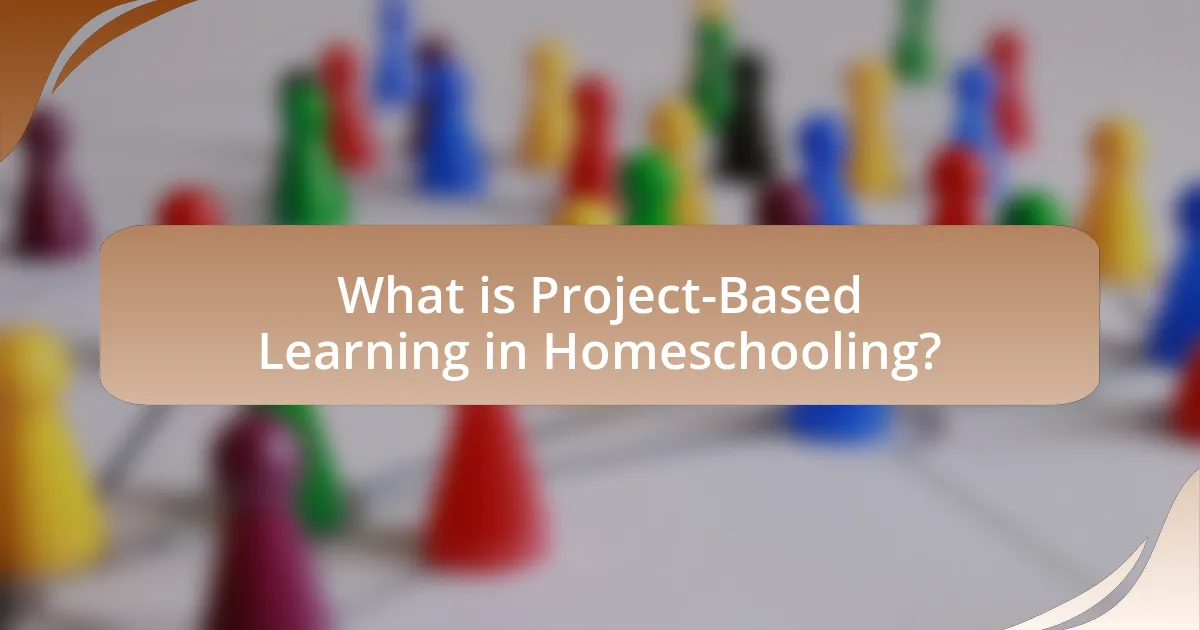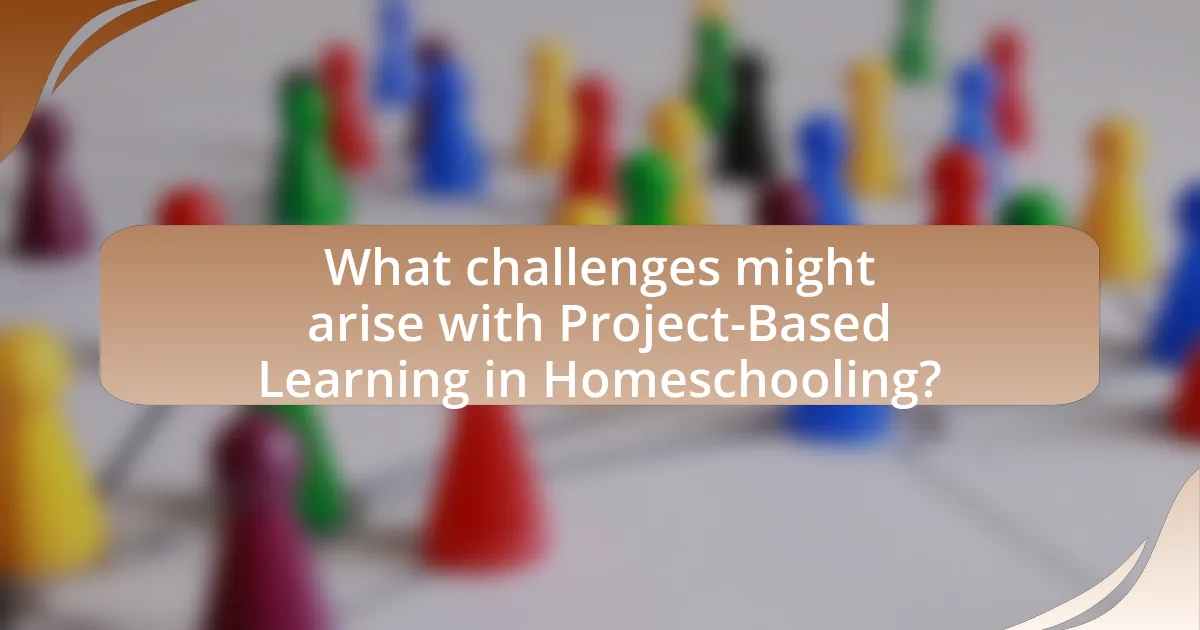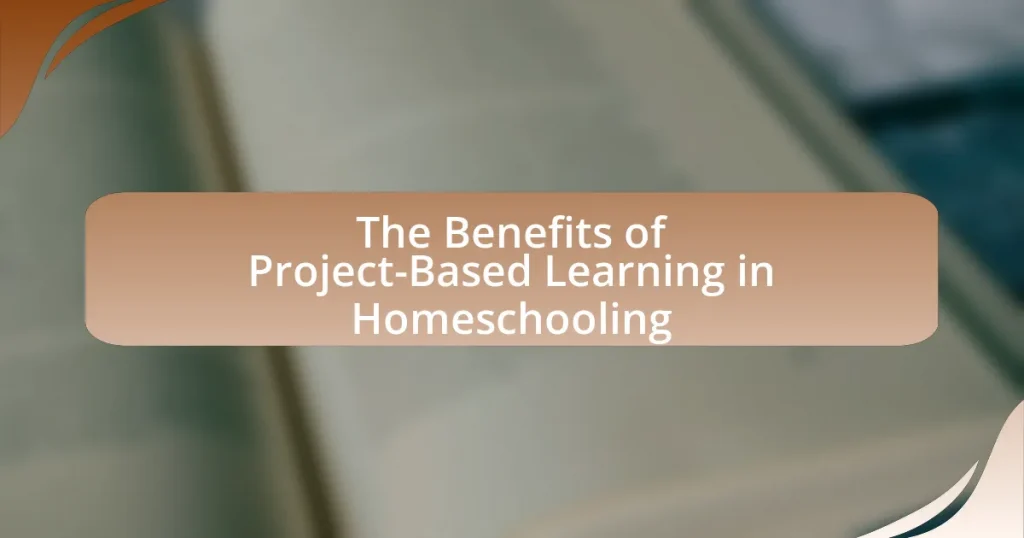Project-Based Learning (PBL) in homeschooling is an educational approach that emphasizes hands-on projects integrating multiple subjects, fostering critical thinking, creativity, and collaboration. This method differs from traditional learning by prioritizing real-world problem-solving over rote memorization, leading to enhanced student engagement and retention of knowledge. Key characteristics of PBL include student-centered inquiry, adaptability to diverse learning styles, and the promotion of teamwork among learners. The article explores the benefits of PBL in homeschooling, including its effectiveness in developing critical thinking skills, accommodating various learning styles, and addressing common challenges faced by families. Additionally, it provides strategies for implementing PBL effectively, assessing student progress, and designing meaningful projects aligned with educational goals.

What is Project-Based Learning in Homeschooling?
Project-Based Learning in homeschooling is an educational approach where students engage in hands-on projects that integrate multiple subjects and skills. This method emphasizes active learning, allowing students to explore real-world problems and develop solutions through research, collaboration, and creativity. Research indicates that project-based learning enhances critical thinking and retention of knowledge, as students apply what they learn in practical contexts, fostering deeper understanding and engagement.
How does Project-Based Learning differ from traditional learning methods?
Project-Based Learning (PBL) differs from traditional learning methods by emphasizing hands-on, real-world projects as the primary mode of instruction, rather than relying on rote memorization and passive learning. In PBL, students engage in collaborative, interdisciplinary projects that require critical thinking, problem-solving, and creativity, fostering deeper understanding and retention of knowledge. Research by the Buck Institute for Education indicates that students in PBL environments demonstrate higher engagement and improved academic performance compared to those in traditional settings, where learning is often fragmented and focused on standardized testing.
What are the key characteristics of Project-Based Learning?
Project-Based Learning (PBL) is characterized by its focus on student-centered, inquiry-based learning through real-world projects. In PBL, students engage in complex tasks that require critical thinking, collaboration, and communication, allowing them to explore and apply knowledge in meaningful contexts. Research indicates that PBL enhances student engagement and retention of knowledge, as evidenced by a study published in the “Journal of Educational Psychology,” which found that students involved in PBL scored higher on assessments compared to those in traditional learning environments. Additionally, PBL fosters the development of problem-solving skills, as students must navigate challenges and create solutions throughout their projects.
Why is Project-Based Learning particularly effective in a homeschooling environment?
Project-Based Learning (PBL) is particularly effective in a homeschooling environment because it fosters personalized learning experiences that align with a child’s interests and learning pace. In homeschooling, parents can tailor projects to suit their child’s unique strengths and preferences, enhancing engagement and motivation. Research indicates that PBL promotes critical thinking and problem-solving skills, which are essential for lifelong learning. A study by the Buck Institute for Education found that students engaged in PBL demonstrated higher retention of knowledge and improved collaboration skills compared to traditional learning methods. This adaptability and focus on real-world applications make PBL an ideal approach for homeschooling.
What are the core benefits of Project-Based Learning in Homeschooling?
Project-Based Learning (PBL) in homeschooling enhances student engagement, fosters critical thinking, and promotes real-world application of knowledge. PBL encourages learners to explore topics deeply, leading to a more meaningful understanding of the subject matter. Research indicates that students involved in PBL demonstrate improved problem-solving skills and higher retention rates compared to traditional learning methods. For instance, a study by the Buck Institute for Education found that students engaged in PBL scored significantly higher on assessments of critical thinking and collaboration skills. This approach also allows for personalized learning experiences, catering to individual interests and learning styles, which can lead to increased motivation and academic success.
How does Project-Based Learning enhance critical thinking skills?
Project-Based Learning enhances critical thinking skills by engaging students in real-world problem-solving and inquiry-based tasks. This approach requires learners to analyze information, evaluate different perspectives, and synthesize knowledge to create solutions. Research indicates that students involved in Project-Based Learning demonstrate improved critical thinking abilities, as they must navigate complex challenges and make decisions based on evidence. A study by Thomas Markham in “Project Based Learning Handbook” highlights that students develop deeper understanding and critical analysis skills through collaborative projects, reinforcing the effectiveness of this educational method in fostering critical thinking.
What role does creativity play in Project-Based Learning?
Creativity is essential in Project-Based Learning (PBL) as it fosters innovative problem-solving and critical thinking skills. In PBL, students engage in hands-on projects that require them to think outside the box, explore various solutions, and apply their knowledge in real-world contexts. Research indicates that creative engagement in PBL enhances student motivation and retention of information, as students are more likely to invest effort in projects that allow for personal expression and exploration. For instance, a study by Thomas Markham in “Project Based Learning: A Bridge to 21st Century Skills” highlights that creativity in PBL not only improves academic outcomes but also prepares students for future challenges by developing their ability to adapt and innovate.
How can Project-Based Learning improve student engagement and motivation?
Project-Based Learning (PBL) enhances student engagement and motivation by fostering active participation in real-world projects that are relevant to students’ interests. This approach encourages students to take ownership of their learning, as they collaborate, problem-solve, and apply knowledge in practical contexts. Research indicates that students involved in PBL demonstrate higher levels of intrinsic motivation, as they see the direct impact of their work and develop a sense of accomplishment. A study by Thomas Markham in “Project Based Learning Handbook” highlights that students engaged in PBL are more likely to retain information and develop critical thinking skills, further reinforcing their motivation to learn.

How does Project-Based Learning support diverse learning styles in Homeschooling?
Project-Based Learning (PBL) supports diverse learning styles in homeschooling by allowing students to engage in hands-on, real-world projects that cater to various preferences and strengths. This approach accommodates visual learners through the use of diagrams and models, auditory learners via discussions and presentations, and kinesthetic learners through active participation in experiments and activities. Research indicates that PBL enhances student motivation and retention of knowledge, as it encourages collaboration and critical thinking, which are essential for different learning styles. For instance, a study published in the “Journal of Educational Psychology” found that students involved in PBL demonstrated higher engagement and achievement across diverse learning modalities, confirming its effectiveness in addressing varied educational needs.
What are the different learning styles that Project-Based Learning accommodates?
Project-Based Learning (PBL) accommodates various learning styles, including visual, auditory, kinesthetic, and interpersonal learning styles. Visual learners benefit from the use of diagrams, charts, and visual aids in projects, while auditory learners engage through discussions, presentations, and listening activities. Kinesthetic learners thrive in hands-on experiences, allowing them to manipulate materials and engage in physical activities related to the project. Interpersonal learners excel in collaborative settings, where they can work with peers to share ideas and solve problems. Research indicates that PBL enhances engagement and retention across these diverse learning styles, making it an effective educational approach for homeschooling.
How can visual learners benefit from Project-Based Learning?
Visual learners benefit from Project-Based Learning (PBL) by engaging with hands-on activities that enhance their understanding through visual representation. PBL allows these learners to create visual aids, such as charts, diagrams, and models, which facilitate deeper comprehension of complex concepts. Research indicates that visual learners retain information better when they can see and manipulate materials, as evidenced by a study published in the Journal of Educational Psychology, which found that students who utilized visual learning strategies scored 30% higher on assessments compared to those who did not. This approach not only caters to their learning style but also fosters critical thinking and problem-solving skills through collaborative projects.
What strategies can be used to support auditory learners in Project-Based Learning?
To support auditory learners in Project-Based Learning, educators can implement strategies such as incorporating discussions, using audio resources, and facilitating group presentations. Discussions allow auditory learners to engage with content through verbal interaction, enhancing their understanding. Utilizing audio resources, such as podcasts or recorded lectures, caters to their learning preference and reinforces concepts. Group presentations provide opportunities for auditory learners to articulate their ideas and receive feedback, further solidifying their knowledge. Research indicates that auditory learners benefit significantly from these interactive and auditory-focused methods, as they align with their preferred learning style, leading to improved retention and comprehension.
How does Project-Based Learning foster collaboration among homeschoolers?
Project-Based Learning fosters collaboration among homeschoolers by creating opportunities for students to work together on shared projects, enhancing their communication and teamwork skills. This approach encourages homeschoolers to engage in group activities, where they can share ideas, divide tasks, and collectively solve problems, thus mimicking real-world collaborative environments. Research indicates that collaborative learning experiences can lead to improved academic outcomes and social skills, as students learn to negotiate roles and responsibilities while developing a sense of community.
What are effective ways to encourage teamwork in Project-Based Learning projects?
Effective ways to encourage teamwork in Project-Based Learning projects include establishing clear roles, fostering open communication, and implementing collaborative tools. Clear roles help each team member understand their responsibilities, which enhances accountability and productivity. Open communication encourages sharing ideas and feedback, leading to a more cohesive team dynamic. Collaborative tools, such as shared digital platforms, facilitate real-time collaboration and organization, making it easier for teams to work together efficiently. Research indicates that structured teamwork in educational settings significantly improves student engagement and learning outcomes, as highlighted in the study “The Impact of Collaborative Learning on Student Engagement” by Johnson and Johnson, which found that students in collaborative environments perform better academically and develop stronger interpersonal skills.
How can parents facilitate collaborative learning experiences?
Parents can facilitate collaborative learning experiences by creating opportunities for group projects that encourage teamwork and communication among children. By organizing activities such as joint research assignments, group presentations, or community service projects, parents can foster an environment where children learn from each other and develop essential social skills. Research indicates that collaborative learning enhances critical thinking and problem-solving abilities, as students engage in discussions and share diverse perspectives. For instance, a study published in the Journal of Educational Psychology found that students who participated in collaborative learning activities demonstrated higher academic achievement and improved interpersonal skills compared to those who worked independently.

What challenges might arise with Project-Based Learning in Homeschooling?
Challenges that might arise with Project-Based Learning in Homeschooling include limited resources, lack of social interaction, and difficulties in assessment. Limited resources can hinder the ability to execute projects effectively, as homeschooling environments may not have access to the same materials or facilities as traditional schools. Lack of social interaction can affect students’ collaborative skills, as they may miss opportunities to work with peers on projects, which is a key component of Project-Based Learning. Difficulties in assessment arise because traditional grading methods may not adequately reflect a student’s understanding or skills developed through project work, making it challenging for parents to evaluate progress accurately.
What common obstacles do families face when implementing Project-Based Learning?
Families commonly face time constraints when implementing Project-Based Learning (PBL), as it requires significant planning and execution. This challenge is compounded by the need for families to balance PBL with other responsibilities, such as work and daily household tasks. Additionally, families may struggle with resource availability, including access to materials and technology necessary for effective project completion. A lack of familiarity with PBL methodologies can also hinder families, as they may not know how to structure projects or assess student learning effectively. These obstacles can lead to frustration and decreased engagement in the learning process.
How can time management issues be addressed in Project-Based Learning?
Time management issues in Project-Based Learning can be addressed by implementing structured timelines and clear milestones for each project. Establishing specific deadlines helps students prioritize tasks and allocate their time effectively, ensuring that they remain on track throughout the learning process. Research indicates that students who utilize time management strategies, such as setting short-term goals and breaking projects into manageable parts, demonstrate improved academic performance and reduced stress levels. For instance, a study published in the Journal of Educational Psychology found that students who engaged in time management practices were 20% more likely to complete projects on time compared to those who did not.
What resources are available to help overcome these challenges?
Resources available to help overcome challenges in project-based learning in homeschooling include online platforms, community support groups, and educational materials. Online platforms such as Khan Academy and Coursera offer structured courses and resources that facilitate project-based learning. Community support groups, often found on social media or local homeschooling networks, provide a space for sharing experiences and strategies. Additionally, educational materials like project guides and curriculum frameworks from organizations such as the Buck Institute for Education offer concrete examples and methodologies to implement effective project-based learning. These resources collectively enhance the homeschooling experience by providing guidance, support, and structured learning opportunities.
What best practices can enhance the effectiveness of Project-Based Learning in Homeschooling?
To enhance the effectiveness of Project-Based Learning (PBL) in homeschooling, it is essential to incorporate real-world applications into projects. This approach allows students to engage with relevant issues, fostering deeper understanding and retention of knowledge. Research indicates that students who participate in PBL that connects to real-life contexts demonstrate improved critical thinking and problem-solving skills. Additionally, providing opportunities for collaboration among students can enhance learning outcomes, as peer interaction encourages diverse perspectives and teamwork. A study by Thomas Markham in “Project Based Learning Handbook” emphasizes that structured reflection throughout the project process helps students internalize their learning experiences, making it a crucial best practice. Lastly, integrating technology tools can facilitate research, communication, and presentation, further enriching the PBL experience.
How can parents design meaningful projects that align with educational goals?
Parents can design meaningful projects that align with educational goals by identifying specific learning objectives and integrating them into hands-on activities. For instance, if the goal is to enhance critical thinking skills, parents can create a project that involves problem-solving scenarios relevant to real-world issues. Research indicates that project-based learning significantly improves student engagement and retention of knowledge, as evidenced by a study from the Buck Institute for Education, which found that students involved in project-based learning scored higher on assessments compared to traditional learning methods. By aligning projects with educational standards and incorporating student interests, parents can ensure that the projects are both relevant and effective in achieving desired educational outcomes.
What assessment methods can be used to evaluate student progress in Project-Based Learning?
Assessment methods used to evaluate student progress in Project-Based Learning include formative assessments, summative assessments, peer assessments, and self-assessments. Formative assessments, such as observations and feedback during the project, help educators gauge student understanding and skills in real-time. Summative assessments, like final presentations or project reports, evaluate the overall learning outcomes at the project’s conclusion. Peer assessments encourage collaboration and critical thinking, allowing students to assess each other’s contributions. Self-assessments promote reflection, enabling students to evaluate their own learning and growth throughout the project. These methods collectively provide a comprehensive view of student progress and learning in a Project-Based Learning environment.
How can families get started with Project-Based Learning in their homeschooling journey?
Families can get started with Project-Based Learning (PBL) in their homeschooling journey by identifying a real-world problem or question that interests their children. This approach encourages engagement and critical thinking, as children work on projects that are meaningful to them. Research indicates that PBL enhances student motivation and retention of knowledge, as evidenced by a study published in the “Journal of Educational Psychology,” which found that students involved in PBL showed higher achievement levels compared to traditional learning methods. Families should begin by brainstorming topics, setting clear goals, and planning the project timeline, ensuring that the learning process is both structured and flexible to accommodate children’s interests and learning styles.










